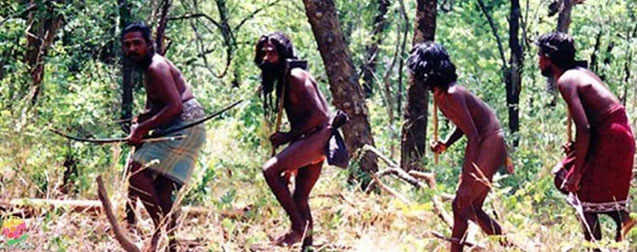Coastal veddahs fiercely proud of the tribal heritage
By Amal Hewavissenti
This discussion focuses on certain aspects of the lifestyle of a
unique people the coastal veddahs or muhudu veddahs whose lifestyle is
intertwined with forest and coastal ecology. Unfortunately, this
indigenous community is disappearing at a terrific pace in the face of
the widespread colonisation and integration.
Though much of their grandeur and original practices have been
compromised to this day, we find their distinct culture and practices
fascinating. Much of what is spoken by these tribal leaders directly
underscore the threat that modern civilisation presents to these people.
 In the same way that the evolution of man since the Stone Age defines
us in this 21st century, understanding indigenous communities and their
cultural, social, economic and scientific heritage has indisputable
relevance in the present time. In the same way that the evolution of man since the Stone Age defines
us in this 21st century, understanding indigenous communities and their
cultural, social, economic and scientific heritage has indisputable
relevance in the present time.
Village
Kunjankalkulam is a coastal veddah village in Batticaloa district and
is situated along the Valachchenai - Vakarai Road. The village is
positioned seven kilometres from the turn at Kajuwaththa near the Kunjan
Kalkulam tank.
As it stands today, there are about sixty eight families of
indigenous origin residing in the village and strangely enough, not a
single individual could connect themselves or their families with a clan
or sub clan of the coastal veddahs or any other veddahs. However, the
officers and soldiers of the military camp stationed in the village
acknowledged that they noticed a distinct difference between these
inhabitants of the village and normal Tamil civilians.
It is a tremendously difficult task to retrieve the real roots of the
coastal veddahs of Kunjankalkulam as they themselves are incapable of
tracing their origin. During the post independence period of Sri Lanka
beginning in 1948, the authorities had taken the prerogative to resettle
these indigenous folk.
The villagers of Mankarni (the point of migration for the coastal
Veddahs in Kunjankalkulam) state that their livelihood was hunting
around two generations previously and they used the jungles in the
vicinity to hunt for prey. The veddahs who lived the traditional
hunter's lifestyle were resettled in Mankarni and subsequently they
underwent a second phase of resettlement in the village of
Kunjankalkulam.
Generations
The earliest generations of these coastal veddahs had used bow and
arrow in hunting and practised traditional veddah customs such as
preserving food using bee's honey, making maximum use of what they
cultivate and fish.
These veddahs who were being streamlined into society had minor
clashes with the native Tamil population and the younger generations
were compelled to attend Tamil schools. Their language gradually became
Tamil and they experienced a certain extent of exploitation by the rich
landowners of the area. However, many of the traditional customs
considered imperative among the coastal veddahs have faded against the
influence of native Tamils and other external factors.
That is precisely why it has become a fast disappearing community.
There are a set of rituals practised by the coastal veddahs. These
rituals are generally considered unique to them.At the birth of a child,
the tradition dictates that the mother drinks a concoction made from
bee's honey and a herb called Kayam - a custom that does not appear
among the Tamil people living in the vicinity. Their marriage customs
bear certain resemblance to traditional Hindu marriage.
And - the leadership among this indigenous community is inherited.
The current chieftain is 75 year-old Sellathambi who is fair in
complexion in contrast to the coastal veddahs who possess dark skin. He
learnt Tamil at the school and spoke the veddah dialect at home with his
parents. His father Kannamuththu and grandfather Chiththira both held
the position of village chieftain prior to their death.
Interestingly, coastal veddahs predominantly pay homage to deities
such as Murugan the God of Katharagama, Pilliyar, the God of wisdom and
Mariamman that the neighbouring Tamils revere. A part from this, the
coastal veddahs worship a common deity called Vardan Deyyam (which means
the lord of veddahs ).
Chieftain
The Kunjankalkulam veddahs refer to their gods by the names of
Udarata Deyyo or Kele Deyyo - both terms describing the environs of the
gods. Coastal veddahs as well as veddahs living in central regions
jointly worship Kiri amma or Kuveni the queen of the Yakshas and whom
many consider to be the mother of all veddahs.
Sellathambi, the chieftain of the clan offers his prayers to a
designated tree standing behind his house.
The tree contains a basic box and cloth in red and white which are
considered sacred among the community. The traditional prayer takes
place during the middle months of the year. They have divided their
deities into two groups namely Pirimi (male) Deyyo and Muhudu Deyyo (sea
god).
Fishery
The chief industry that the members of Kunjankalkulam tribal village
have taken up is fishery.
They have apparently forgotten their basic and unique armour for this
purpose, the Mullambu was used broadly by the earlier coastal veddahs.
Most of the current community seem to avoid using this tool and they
recall how their forefathers used this weapon with precision to kill
fish.
The coastal veddahs use fumigation to collect bees honey. According
to the tribes in Kunjankalkulam, they simply throw the hive up into the
sky and let gods dance and play with bees, while they are up in the sky.
The collectors then takes the honey they need and leave the excess
portion for the bees so that bees can resume their nest.
Sellathambi claims that they have never been stung by bees in the
process of collecting honey. |

